Deadheading Geraniums: A Guide to Encourage New Blooms
This article has links to products that I may make commission from.
Geraniums are a popular choice for gardens as they are known for their vibrant colors and easy care.
They are an excellent choice for a south facing garden because they thrive in full sun and heat and they offer vibrant color.
Deadheading is an essential practice for promoting new growth and encouraging geraniums to produce more blooms.
By removing the faded flowers and stems, you can help the plant to redirect its energy towards producing new blooms, resulting in a more abundant and long-lasting display of color.
Here we'll explore why deadheading geraniums is important, when and how to deadhead, and other care ideas to keep your geraniums healthy and thriving.
To learn more about the art of deadheading, check out my guides:
An amazing display of geraniums in Vejer de la Frontera, Spain.
For more tips, check out my guides:
Why Deadhead Geraniums?
Deadheading geraniums is an important practice that helps to maintain the health and appearance of the plant.
When a geranium plant produces flowers, it expends energy to create and maintain the blooms.
As the flowers begin to fade and die, the plant will redirect its energy towards producing seeds.
This means that if the faded flowers are left on the plant, the energy that could be used to create new flowers will instead be used to produce seeds.
By deadheading geraniums, you can prevent the plant from wasting its energy on seed production and instead redirect its resources towards producing new flowers.
This can result in a longer blooming period and more abundant blooms throughout the growing season.
In addition to promoting new growth, deadheading annual geraniums can also help to keep the plant looking neat and tidy.
Faded flowers can be unsightly and can detract from the overall appearance of the plant.
By removing them, you can help the plant to maintain a healthy and attractive appearance.
It is important to note that deadheading geraniums is not strictly necessary for the plant's survival, but it can help to promote optimal growth and blooming.
Geraniums are hardy plants and can thrive with minimal care, but regular deadheading can help them to reach their full potential and provide a stunning display of color in your garden or landscape.
Overall, deadheading geraniums is a simple and effective way to promote new growth and maintain the health and appearance of the plant.
By removing faded flowers, you can help your geraniums to produce more abundant and vibrant blooms throughout the growing season.
Deadheading is also an essential practice for promoting new growth on snapdragons.
Check my guide:
How to Deadhead Geraniums
Deadheading geraniums is a simple process that can be done by hand or with pruning shears.
Here are the basic steps for deadheading geraniums:
Wait until the flowers on the geranium plant have started to fade or wilt.
It is important to wait until this point, as removing the flowers too early can actually slow down the plant's blooming process.
Locate the flower stem that needs to be deadheaded.
This is the stem that the faded flower is attached to.
Use your fingers or pruning shears to cut the stem of the faded flower down to the first set of leaves.
Make sure to make a clean cut, as ragged or torn cuts can leave the plant vulnerable to disease.
These pruning shears are the ones I recommend for the job:
Repeat this process for all of the faded flowers on the plant.
Dispose of the removed flower stems and debris in the trash or compost bin.
Water the geranium plant to help it recover from the stress of deadheading.
Deadheading geraniums regularly throughout the growing season can help to promote new growth and encourage the plant to produce more abundant blooms.
It is important to deadhead the plant regularly, as leaving too many faded flowers on the plant can cause it to slow down or stop blooming altogether.
In addition to deadheading, it is important to provide your geraniums with proper care, including regular watering, fertilization, and pruning.
Pruning is another essential practice for promoting more flowers.
Check out my guide:
When to Deadhead Geraniums?
Knowing when to deadhead geraniums is crucial for promoting new growth and encouraging the plant to produce more blooms.
Here are some general guidelines to help you determine when to deadhead your geraniums:
when the flowers have faded or wilted:
This is the most obvious time to deadhead, as removing the spent flowers will prevent the plant from using energy to produce seeds and redirect its resources towards producing new blooms.
regularly throughout the growing season:
Regular deadheading, about once a week, will help the plant to produce more abundant blooms and extend the blooming period.
Stop deadheading geraniums in the fall:
As the growing season comes to an end and temperatures begin to cool, stop deadheading your geraniums to allow the plant to prepare for winter dormancy.
Deadhead geraniums in the morning or evening:
Deadheading geraniums during the heat of the day can stress the plant and make it more vulnerable to disease.
It is best to deadhead in the cooler morning or evening hours.
Deadhead geraniums after a heavy rain.
After a heavy rain, the geranium flowers may become waterlogged and begin to mold or rot.
Deadheading after a rain can help to prevent these issues and keep the plant healthy.
For more garden tips, check out my guides:
Plants That Deter Cats: A Natural Solution to Keep Cats at Bay
CAre tips for Geraniums
Watering
Geraniums require regular watering to stay healthy, but they are sensitive to overwatering.
Water the plant deeply once a week, and allow the soil to dry out slightly between waterings.
To water geraniums, you can use rainwater harvested from a water butt.
Fertilization
Geraniums benefit from regular fertilization throughout the growing season.
Use a balanced fertilizer every 4-6 weeks, or as directed on the fertilizer package.
Here is the organic all-purpose complete fertilizer I recommend using:
Pruning
Regular pruning can help to keep your geraniums looking neat and tidy, and can also help to promote new growth and blooming.
Prune the plant as needed to remove dead or diseased foliage, or to shape the plant to your desired size and shape.
These pruning shears are the ones I recommend for the job:
Pests and Diseases
Geraniums are relatively hardy plants, but they can be susceptible to pests and diseases.
Keep an eye out for common pests like aphids, spider mites, and whiteflies, and treat as needed with an insecticidal soap or oil.
Remove any diseased or infected foliage promptly to prevent the spread of disease.
This is the best insecticidal soap:
Winter Care
In colder climates, geraniums are typically grown as annuals and will not survive the winter outdoors.
To overwinter the plant, you can dig it up in the fall and pot it in a container to bring indoors.
Keep the plant in a cool, dark location and water sparingly until spring.
Looking for garden inspiration?
Check out my guides:
Does Fertilizer Go Bad? The Reality of Fertilizer Shelf Life
Deadheading geraniums is an essential part of caring for these beautiful plants.
By removing faded flowers, you are helping to promote new growth and ensuring that your geraniums bloom all season long.
Remember to deadhead your geraniums regularly, and also provide them with regular care such as water, fertilizer, and sunlight.
With a little bit of care, your geraniums will provide your home garden with stunning blooms all season long.








